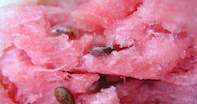
Plant Description
Watermelon is a cucurbit and part of the Cucurbitaceae family. It grows in a flat vine that sends out tendrils that spread across the ground. The plant produces both male and female flowers on the same plant.
The watermelon has an extensive shallow root system and it is therefore very important to control weeds and irrigate regularly as most of the roots are in the top 20 cm of soil. These roots can spread throughout the area covered by the leaves and vines.
It also has a tap root that descends to about 40 cm. The fruit traditionally has skin that is dark green and flesh that is dark red when ripe. There are now watermelons with black, yellow and pale skins and flesh that is red, yellow, orange and white.
Uses
Watermelon is mostly enjoyed eaten fresh and is also juiced. The fruit and rind is also used in jams and preserves.Soil Requirements and Preparation
Watermelon requires a sandy loam to loam soil with a pH of between 6 and 7. The soil should have a good level of organic composition otherwise this should be added in the form compost or manure or of cover crops which should be sown ten to twelve weeks before planting.
Once it has grown, the cover crop is then mixed into the soil before the expected planting time. As a rule take soil samples about 14 weeks before the expected plant date and submit samples for analysing and nutrient requirement recommendations.
Once the soil analysis is received about 12 weeks prior to planting, apply lime for pH rectification and gypsum for calcium and compost or manure for organics. Plough these additives into the soil, mixing the top 500 mm of soil. This also ploughs in previous crop residues and any weeds that have grown since the past harvest.
A green cover crop is always a good idea as this also controls weeds and will add further organic substance to the soil. Sow the cover crop and till seeds in with a tooth harrow. This levels the surface and covers the seeds with minimal soil.
About three to four weeks from planting, mow the green cover crop and spread compost or manure and plough this in, turning the soil 400 to 500 mm deep.
With a disk harrow level and cut the soil and any residue turning the top soil into a fine clod free consistency. Leave the ground to settle. In the final week before planting apply the pre-harvest fertilizer recommended and any required trace elements like boron and Zinc and disk harrow this into the top 20 cm of soil.
This also acts as a final weed control action. If ridging is to be done or drip lines laid or plastic mulching, then this is done at this stage as well. The soil is now prepared for planting watermelon seeds or seedlings.
Climate
Watermelons, as with all cucurbits, like a warm climate and grow best when temperatures are between 18°C and 30°C. The growth is all but halted when temperatures drop below 10°C and is very sensitive to frost and plants can die if exposed to temperatures below 5°C for extended periods. Excessively high temperatures of over 35°C are also damaging to the plant and expected yields.Cultivars
There are close to a hundred different varieties of watermelons with new hybrids being developed all the time as tastes change and markets evolve. The main types grown in South Africa are All Sweet, Crimson Sweet, Super Small and Seedless varieties.
Some varieties available in South Africa are Sugar sweet, Charleston, Congo, Sugar baby, Moon and Stars, Daytona, Sensei, White wonder, Yellow Petite and Starlight.
It is however best to get cultivar advice from the local extension officer and local seed advisors before you decide. They will be able to suggest the most suitable cultivars for a particular area and growing conditions.
By Louise Brodie